Add Custom Child
Children of any type of object or variable can be added in this dialog. If a child is not a part of the parents type, the child will not have a modelling rule.

Enter data for your new child to the left side of the dialog. Press the Add button when done. You can add multiple children in this dialog. The new children are listed in the table below the Add button. New children are not created before you press the Ok button.
An overview of the child’s type is visible at the right hand-side of the dialog. It is also possible to select optional children, change types and create custom ids in the type overview. (Custom ids presuppose that the target namespace requires this).
| Property Name | Description |
|---|---|
| Namespace | The target namespace where new children will be stored. |
| Browse name URI | The BrowseName may be stored in another namespace. |
| TypeDefinition | The type of the child instance. Visualized in the right side of the dialog. Use the browse button to locate the type. |
| ReferenceType | The type of the reference from the parent to this child. Use the browse button to locate the type. |
| Displayname | The text part of the DisplayName. |
| Browsename | The text part of the BrowseName. |
| Description | The description of the child. |
Abstract Data Types:

If the type definition contains children with abstract types (red symbol), you must select a non-abstract type for the child. This is done by clicking on the red symbol and selecting a type from the browsable tree that appears.